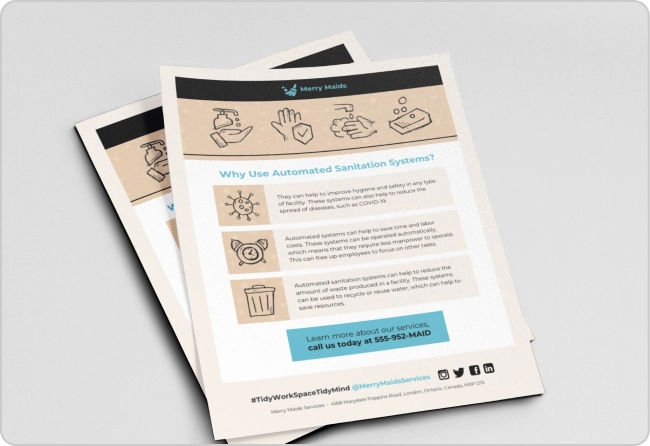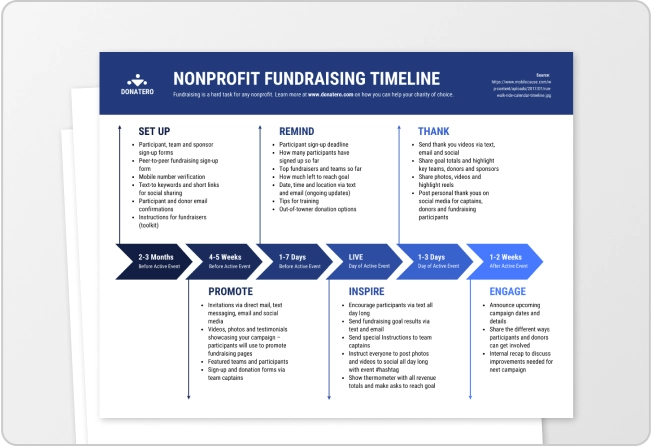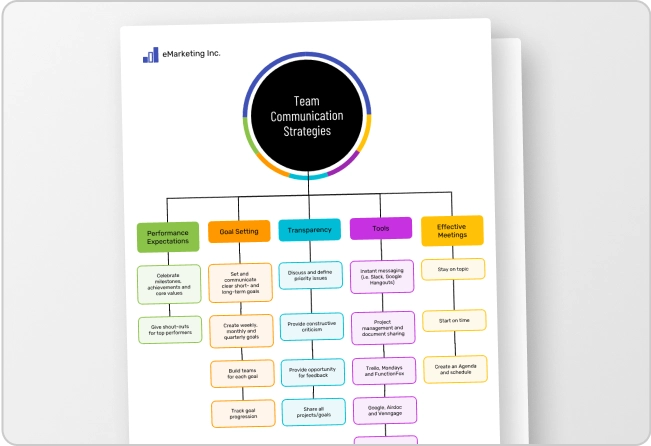For organizations that need to report metrics like consumer demographics, sales performance, or population density across market segments, one of the biggest challenges is how to illustrate the data in a way that their intended audience will understand.
Choropleth maps are a widely used and effective method for visualizing geographic data.
Let’s explore more about this solution and learn how you can create a choropleth map easily using Venngage’s Choropleth Map Templates.
What is a choropleth map?
A chloropleth map is a thematic map that is used to represent statistical data across geographic areas. It uses the color mapping symbology technique, which means coloring regions using different colors or tones to show variations in the data,
Chloropleth maps show variation or patterns across the displayed location and help visualize values over a geographical area.
For example. this chloropleth map template shows the growth of customer base across different regions over the course of three years.
How to read a choropleth map
To read a choropleth map, you have to read the instructions first as well as the color key or legend to understand what the shading or the pattern means.
Here’s the step-by-step process to read a chloropleth map:
- Look at the title: It tells you the data point shown on the map (e.g., population density, sales growth, literacy rate).
- Check the legend: The legend explains the color scale—usually from light (low values) to dark (high values), or from one color tone to another.
- Match colors to values: Compare the shades on the map with the legend to understand what each region’s color means.
- Notice patterns: Look for clusters, contrasts, or trends across regions (e.g., darker areas may show higher income levels or greater customer growth).
- Keep context in mind: Remember that colors show intensity, not exact numbers, and that larger regions don’t necessarily mean larger values, but higher or lower rates.
This chloropleth map template, for example, shows how the population has changed across different counties. The legend explains what each color means—for example, lighter shades represent areas with little or no decline, while darker shades show counties with larger population losses.
By matching the colors on the map to the legend, you can quickly see which regions are witnessing rapid population decline and which are relatively stable.
What is a choropleth map used for?
Choropleth maps are useful when the data you want to convey is:
- Attached to enumeration units like cities, counties and countries,
- Standardized to show rates or ratios, and
- Follows a continuous statistical surface, meaning measurable values occur everywhere within the area of study and not just at specific locations.
This thematic map visualizes the amount of money each American state (enumeration units, within a continuous statistical surface) spends on health care in relation to the country’s GDP (standardized data).
It’s important to note that raw data isn’t recommended here. Choropleth maps are especially useful for showing normalized data, like per capita or per square kilometer rates.
This is because choropleth maps are comparative by nature. They’re commonly used to compare relative data and highlight their differences across geographic locations.
For example, to map restaurants per capita, you’d divide the total number of restaurants by the population of each county, giving you restaurants per person. Similarly, you might map population density by calculating people per square km to compare how crowded different regions are.
How to create choropleth maps?
Now let’s see how you can create cholorpleth maps to visualize your data.
Step 1: Collect and organize data
Gather statistical data associated with geographic regions (e.g., unemployment rate by state). Then, normalize the data (adjust the raw numbers so they can be compared easily). Here’s how:
- Rate = cases per population (e.g., cases per 100,000 people)
- Density = value per area (e.g., population per square km)
Step 2: Choose a diagram or design platform
You can use platforms like Datawrapper or Atlas to create a choropleth map. Just choose the geographic region, upload your data in CSV or Excel, pick a color palette, and your map is ready. The catch is that these tools don’t let you add extra design elements like icons or your brand logo.
If you’re looking for something more beginner-friendly, Venngage makes it easy with ready-to-use choropleth map templates. You can customize colors, add icons and even apply your own branding elements, such as logo and fonts.
Step 3: Select a choropleth map template that fits your purpose

Use the data classification methods mentioned above to choose your map template.
You should also think about the color ramp of your map: sequential (changing color gradient), diverging (gradual change of colors) or categorical or qualitative (color combinations).
This comparative map makes use of a categorical or qualitative color combination, using different shades of black and grey to effectively illustrate the differences between the data presented.
Step 4: Edit the data and text as you need
To edit, simply double click the map. A map editor pane will appear in which you can copy and paste the data in or import your data using a .csv file:

When designing a choropleth map, use the smallest available unit—such as counties instead of states, or countries instead of continents—for greater detail. This will help you give your readers a refined image of the information.
Step 5: Customize your thematic map
To edit the color of the map, you can double click the map and choose “Setup” in the map editor pane. Here you can edit the colors of the two extremes, the color of the map when hovered over, etc.

After ensuring a perfect data visualization of the information you want to convey, share your design directly using a share link.
You can also upgrade your account to download your map in multiple formats (PNG, PNG HD, PowerPoint (to use with your slides) or PDF).

What are the different choropleth map data classification methods?
Data classification arranges the data you include in your choropleth map with boundaries to separate each class from one another. The following are the different data classifications:
Natural break classification
Natural breaks is the default classification available for choropleth maps. Here, classes are based on natural groupings inherent in the data. This classification method should not be used to compare maps created with different data but only when you want to emphasize the natural groupings in your data.
This classed choropleth map presents information classified according to geographic regions. The data’s natural groupings are highlighted by their colors and legend.
Equal interval classification
The equal interval classification method divides the range of attribute values into equal-sized sub-ranges. It emphasizes the amount of an attribute relative to other values and is commonly used for data that has familiar ranges.
A simple yet appealing classed choropleth map like this presents the percentage of adults with a bachelor’s degree or higher per state in equal intervals. Its matching color scheme, shapes, and fonts can be customized to best represent your data.
Quantile classification
The quantile classification method divides the attributes into binds with equal numbers of features. For example, a map that illustrates the rates of population growth of all 50 American states (attributes) might be divided into five quantiles or sub-groups with 10 states each (binds with equal numbers of features). Each quantile will be represented by one color on the map.
The trouble with this method, however, is that it can complicate the look of your choropleth map as it can place similar values in different classes.
For instance, in the earlier mentioned example, the rates of population growth might be divided based on the data’s chronological order (i.e. highest to lowest) versus the states’ geographic arrangement. In this case, the quantile colors will be scattered on the map instead of organized per area.
This is why this method is better used on data that is relatively uniform. However, it can also be used as a method of visual ranking.
Standard deviation classification
The standard deviation classification method illustrates how much the data per geographic location deviates or differs from an average value.
This method works best on datasets that are normally distributed and for analyses in which the mean, or the distance from the mean, is crucial.
For example, a map that wishes to show how much Americans in every state spend on groceries compared to a national average amount per year.
Unclassed classification
The unclassed classification method is used when numeric data is displayed on a continuous scale, rather than in discrete classes. When you want to see gradual changes in your data, you can do so using this method.
Here’s an example of an unclassed choropleth map:
This map illustrates the average price of gas per American state through color codes and a scale that contextualizes the different shades.
Manual classification
From the name itself, a manual classification method means that you manually add class breaks that are appropriate for your data.
It should be used when there are known ranges that must be applied to your information, such as when you want to create a series of choropleth maps with the same classes or sub-groups to show their relation to one another.
You don’t need to be a data analyst or graphic designer to create choropleth maps
Choropleth maps are an easy and effective data visualization method to illustrate different values across geographic regions. Your audience also doesn’t need to be experienced map readers to make use of choropleth maps.
It’s easy to start creating choropleth maps using Venngage templates. Simply sign up for a free account and give our drag-and-drop editor a test drive!
Choropleth map FAQs
1. What is a choropleth map used for?
A choropleth map is used to show how a variable changes across geographic areas. It’s great for visualizing things like population density, unemployment rates, election results, or any other value that varies by region.
2. What’s the difference between a choropleth map and a graduated symbol map?
A choropleth map shades entire regions based on data values (e.g., darker colors = higher values). A graduated symbol map uses symbols of different sizes (like circles) placed on a map to represent the magnitude of a value at a specific location.
3. When should I normalize data for a choropleth map?
Almost always. Normalizing data (e.g., cases per 100,000 people instead of total cases) ensures you’re comparing regions fairly. Without normalization, larger regions might look “worse” just because they have bigger populations.
4. What’s the best color palette for a choropleth map?
Use a sequential palette (light to dark) when showing data that goes from low to high. For data with a meaningful midpoint (like profit vs. loss), use a diverging palette (two contrasting colors that meet in the middle).












































